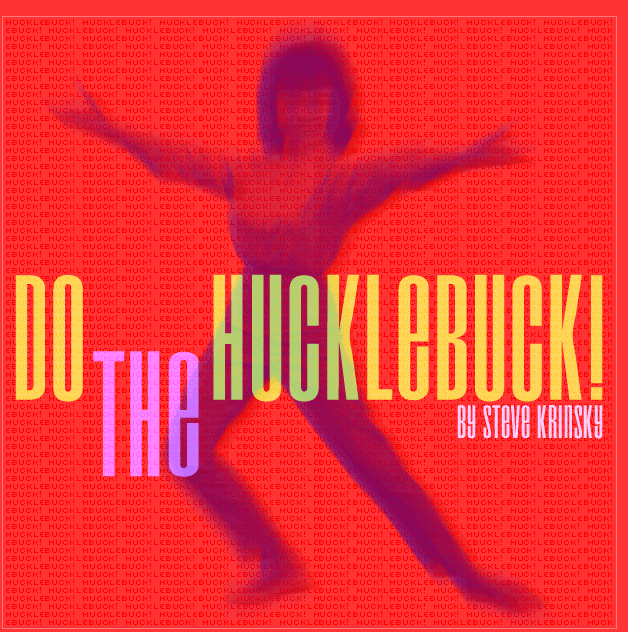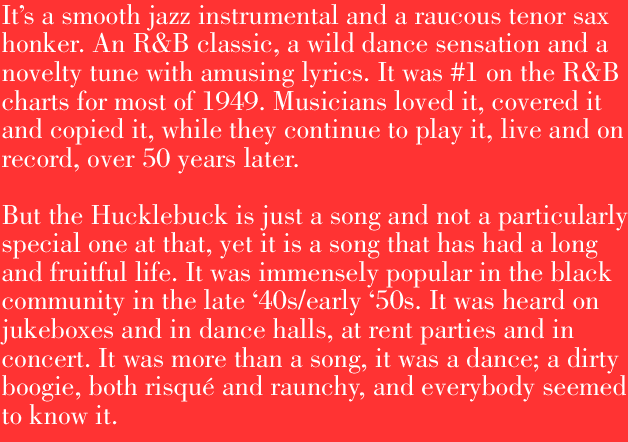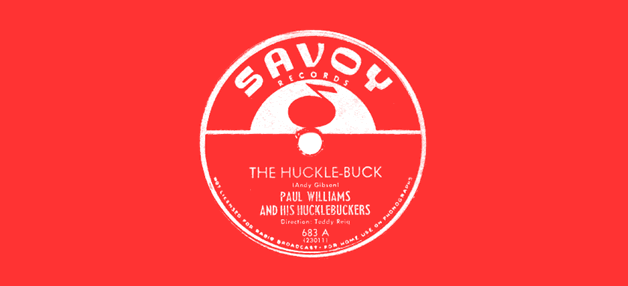

In the early days, it was recorded by dozens: everyone from Sinatra and Louis Armstrong to Pearl Bailey and Kate Smith to Lucky Millinder and Earl Hooker. Even Ralph Kramden, that aficionado of African-American culture, had a touch of soul when he did the Hucklebuck
However, the Hucklebuck is also a song with many stories to tell: about record labels and music producers, bandleaders and songwriters, creativity and commerce, race and records, Jazz vs. R&B and these are all important stories. It also involves the emergence of rock and roll (aka white kids listening to black music) that's another story about how ideas evolve, get transformed, get ripped off, get lost and found.
Herman Lubinsky was Newark's skinflint music mogul. Out of his record store on Market Street he ran Savoy Records, named after the popular Harlem nightspot. His policy at Savoy was sell records and avoid paying for the music. Herman was not popular with musicians, who he shortchanged a few too many times, but he had a knack for hiring savvy record producers who knew how to make great music into hits. These were mostly jazz and R&B hits, starting in the 1940s. Lubinsky's style of doing business, only somewhat ironically, paid off. At one session in November 1945, Teddy Reig, Savoy's premier producer, had to remind Charlie Parker that Lubinsky wouldn't pay for other people's tunes, that every song had to be an original. So Bird, stuck for a fourth number, "wrote" a song on the spot. It was simple: he took a jazz standard which he had played many times and transformed it into something else. The band at the time, just as Bebop was about to take off, was hot. The line-up was Bird, Dizzy Gillespie, Max Roach, Curly Russell, Sadik Hakim and a 19-year-old Miles Davis. At the session Bird's alto saxophone soared and "Cherokee" became "Koko," which many consider the quintessential bebop number.
Despite this, there were no royalties. Lubinsky was already paying Parker for the session and the tunes came along for the ride. Did Bird steal "Cherokee"? Truthfully, he did what all great artists do: he took an idea, albeit someone else's idea, and re-shaped it. When he was done, it wasn't "Cherokee" anymore. "Koko" is its own song, an original in its own way.
Now's
The Time
At
that same 1945 session, Bird and band did another original. "Now's the
Time" is an easy blues with a memorable riff. The tempo is hurried, in
Bird's style, while the riff that holds the chorus together stands out.
No one knows where he got the simple/familiar bluesy beat, but that riff
soon turned up again, in full force, at another Teddy Reig session about
three years later with Detroit bandleader Paul Williams, also recording
for Savoy Records. The riff returned and became the "Hucklebuck" and the
world of Rhythm and Blues would come to remember it well.
Teddy Reig was a large fellow, a street smart "jazz hustler" (as he liked to call himself) with years in the business to prove it. But the "Hucklebuck" wasn't just a rip-off of "Now's the Time," although Teddy Reig relished the connection. "The one was jazz, the other was rock and roll, and we were hungry," he once said. "And Lubinsky owned everything anyway."
There seems no doubt that everyone involved in that November 1949 session: Paul Williams, Teddy Reig and songwriter Andy Gibson had heard the Charlie Parker tune. But the "Hucklebuck" was a loping tenor sax instrumental, not a frenetic bebop number. "It's not the same song," Paul Williams told me in a phone interview. While the lyrics would be added later, the tune was an instant hit, knocking "Boogie Chillun," by young John Lee Hooker off the top spot on the R&B charts and breaking all records at that time for popularity. It sold half a million copies by some estimates, and although Lubinsky complained about this, the money came pouring in.

Start
A Little Movement In Your Sacroiliac
As a dance craze, the song's popularity was widespread. LeRoi Jones mentions
people dancing the Hucklebuck at rent parties in Newark in the late '40s,
night after night "until they dropped." Whoever came up with the name
must have anticipated the sexual innuendo, as the lyrics written by Roy
Alfred, are mildly suggestive, while the dance was just as bad. "That
Hucklebuck was a very nasty dance," recalls Virginia Robichaw, a teenager
in Philadelphia when she first heard the song. "They used to get down
I don't know how they did it. They would do the dance, the hucklebuck,
and they would get down on their back and the guy would stand over top
of 'em."
When Paul Williams toured with the Hucklebuck in those days, the crowds got rowdy. With honking histrionics on stage and suggestive dancing offstage, the shows were sweaty riotous affairs that got shut down on more than one occasion, as the sexual energy got just too overheated. Once the band hired a midget to dance up on the bar while they Hucklebucked. Teddy Reig claims to have taught Paul Williams a little "choreography" to spruce up the show; kicking as he played, bending and dipping, getting down on the floor while blowing that saxophone. The honking, sometimes just one note over and over, turned the horn into a rhythm instrument.
Paul Williams and his Hucklebuckers were one of the headliners (along with Tiny Grimes Rockin' Highlanders) for Alan Freed's First Moondog Coronation Ball in Cleveland in 1952. But a funny thing happened on the way to the concert: they only had 10,000 seats, but three times that showed up, causing a riot.
Hucklebuck
Is Everywhere
Paul Williams was the Hucklebuck. He admits that the tune defined his
career, even becoming his middle name. But, as we'll see, he wasn't the
first or last to play the song, as the Hucklebuck was as popular with
musicians as it was with audiences. Every band did a version: rhythm and
blues, big bands, pop vocal, blues, novelty versions and more. By 1952,
Hucklebucks (or its many variations) were recorded by Lucky Millinder,
Roy Milton, Jimmy Liggins, Pearl Bailey and Hot Lips Page, Louis Armstrong,
Jimmy Preston, Frank Sinatra, Tommy Dorsey, Kay Starr, Georgia Gibbs and
others.
Roy Milton's version has his band singing the lyrics in unison, while Pearl Bailey and Hot Lips Page do the vocals with a charming yet suggestive banter. Louis Armstrong performed the song on tour in the early '50s with vocalist Velma Middleton, a 300 pound singer and dancer who, according to jazz historian Dan Morganstern, "could do a mean split." In 1956, Jackie Gleason built an entire episode of The Honeymooners around the song; where Ed Norton teaches Ralph how to dance "this hot number," as they proceed to party down.